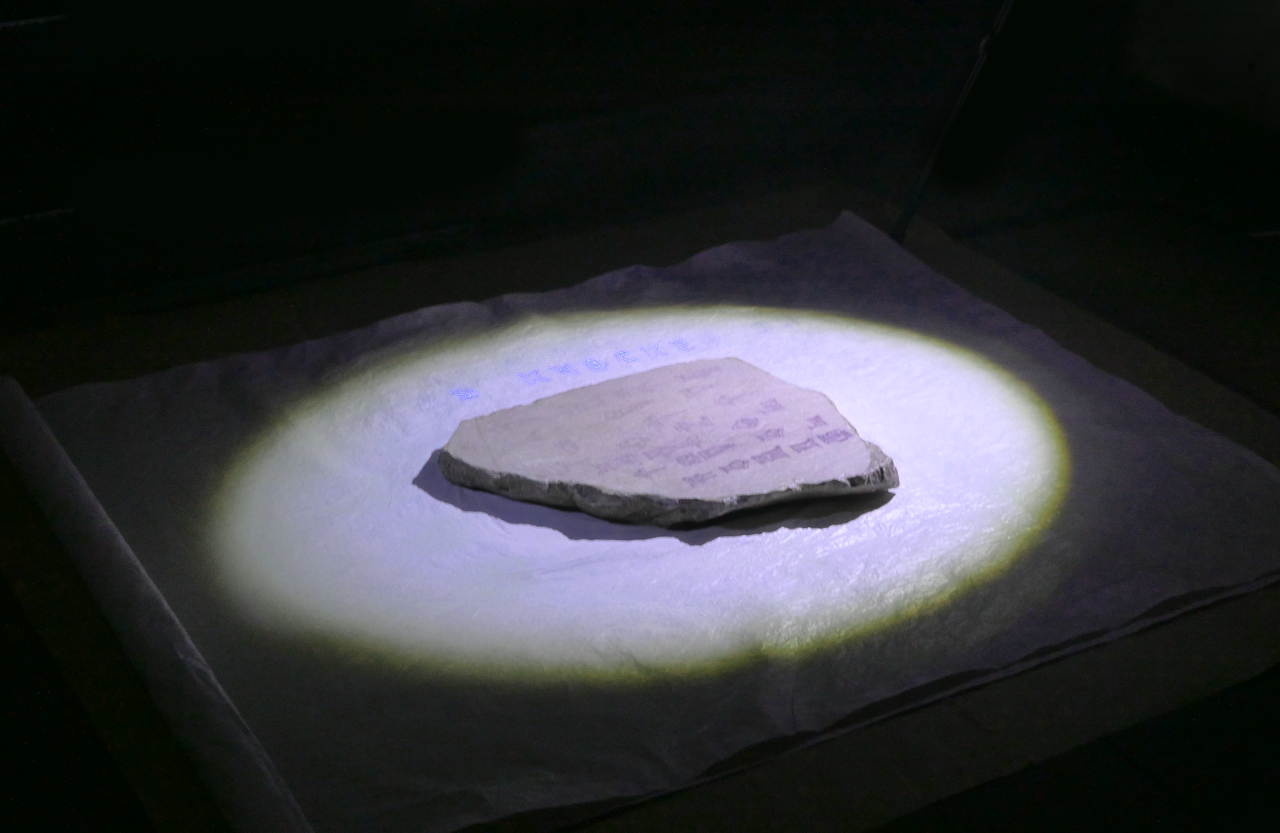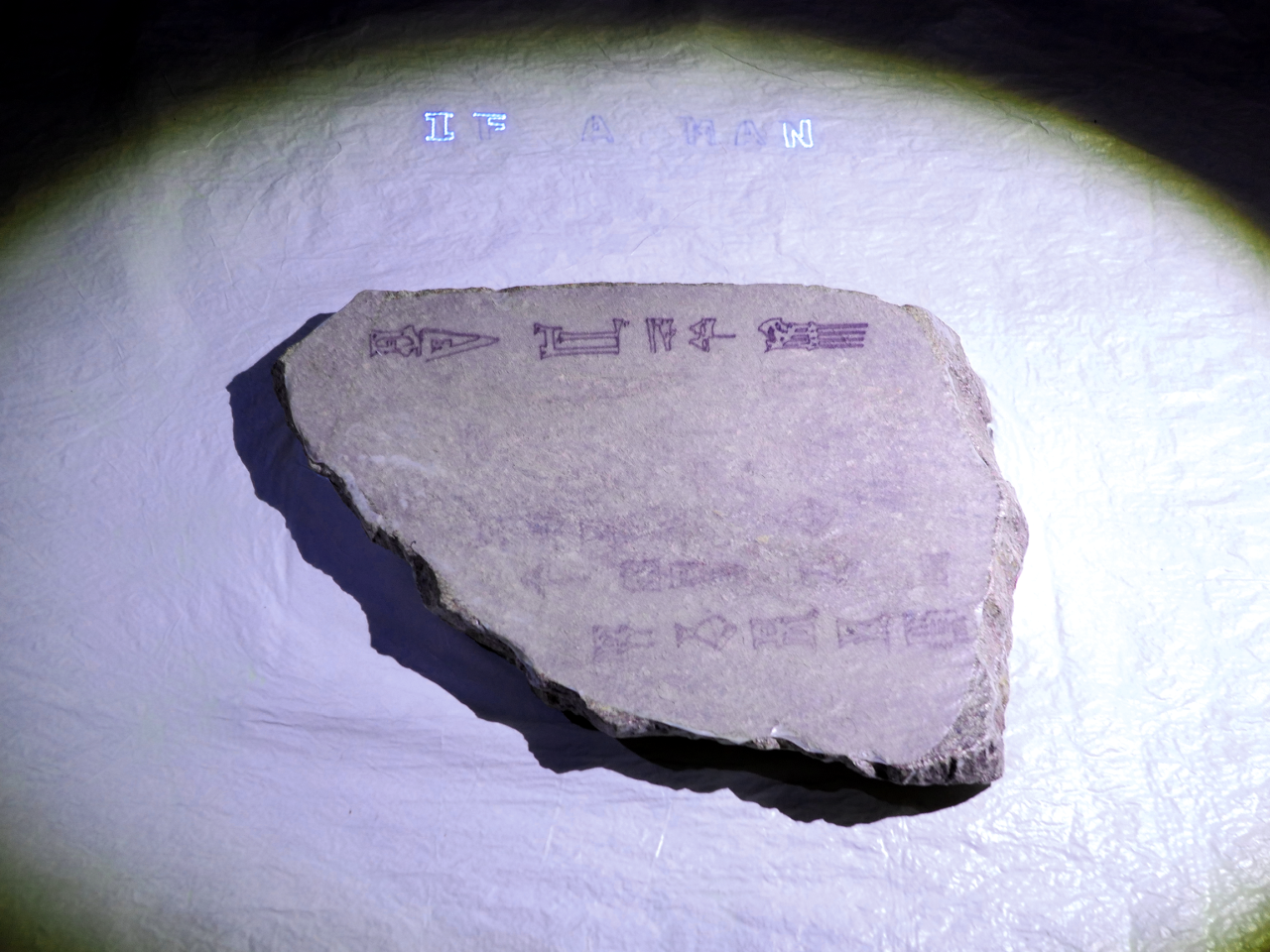Idea
Šūtum is a mixed media installation that reflects on the impermanence of laws, norms, and their interpretations. Utilizing an ultraviolet laser and photochromic pigments, the artwork creates ephemeral images of ancient laws on a stone surface that gradually disappear, symbolizing the fragility and mutability of human constructs.
 photo: Slava Romanov
photo: Slava Romanov
The title Šūtum, meaning “south wind” in the Akkadian language, symbolizes change and transformation. The south wind represents forces of change and impermanence, juxtaposing concepts of permanence and transience, and highlighting the cyclical nature of history and human constructs.
The installation references the Code of Hammurabi and the talion principle (“an eye for an eye”), exploring how ancient notions of justice continue to influence the modern world. The appearing and disappearing cuneiform texts in Akkadian serve as a metaphor for ongoing questions about justice and retribution, and how ancient laws persist or resurface in contemporary contexts.
Photos: Slava Romanov
Context
Delving deep into history, Šūtum employs the Akkadian language and cuneiform—one of the oldest writing systems originating in Mesopotamia around 3000 BCE. Akkadian was used from approximately 2500 to 1000 BCE and served as the lingua franca of the ancient Near East, connecting diverse cultures and peoples.
The Code of Hammurabi, inscribed on stone steles around 1754 BCE, represents one of the earliest known legal codes, establishing rules and norms for society.
The talion principle, reflected in these laws, prescribes equivalent retribution for harm caused. The selected articles for the installation emphasize this idea:
- Article 196: “If a man has blinded the eye of a member of the awīlum class, his eye will be blinded.”
- Article 197: “If he has broken a man’s bone, his bone will be broken.”
- Article 200: “If a man has knocked out the tooth of a man of his own rank, his tooth will be knocked out.”
The installation juxtaposes these ancient norms with contemporary notions of justice, highlighting that despite the evolution of laws, some fundamental principles continue to recur. In the modern world, we encounter phenomena reminiscent of the resurgence of the talion principle, especially in the context of international conflicts and “retaliation strikes.”
Technical Side
The project utilizes a combination of technologies and materials:
- Ultraviolet Laser: Serves as a tool to “etch” images onto the stone surface, symbolizing the blade of time and light.
- Photochromic Pigments: The stone surface is treated with pigments that react to UV radiation:
- Long-lasting Pigment: Preserves the image for up to 1.5 minutes, allowing the viewer to observe the details.
- Fast-fading Pigment: The image disappears within 5–7 seconds, creating a sense of ephemerality and transience.
- Galvanometer Scanner: A self-assembled combination of a galvanometer and a 405nm low-power focused laser, based on a programmed microcontroller, combines fast and slow rendering methods to produce both immediate and gradually evolving visual forms.
Photos: Slava Romanov
Presentation
Šūtum was presented at the Goldstücke festival in Gelsenkirchen (DE) from October 2–6, inviting visitors to contemplate the continuity and mutability of laws and norms. The installation offers a meditative experience as viewers observe the appearing and disappearing images, evoking personal associations and reflections on justice, history, and modernity.

photo: Slava Romanov
The project was realized under the guidance of Professors Lorenz Potthast (conceptualization) and Bettina Pelz (curatorial support and mentoring).
Links
Author
- Slava Romanov: Concept, design, and execution



